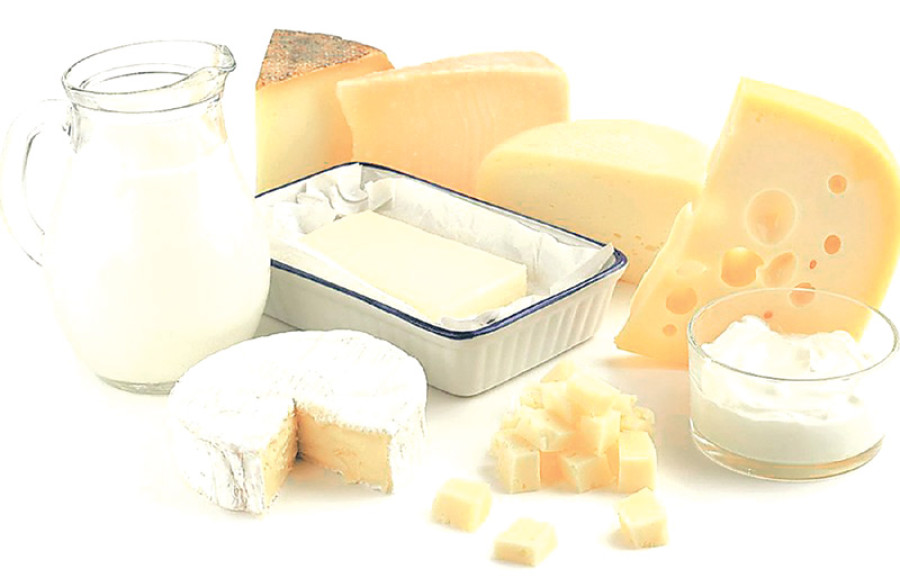Opinion
Land of milk and honey
Nepal produces 1,725,000 tonnes of milk annually. The Tarai has a higher growth rate, and milk output here is higher than in the hills.
Nanu Jha
Nepal produces 1,725,000 tonnes of milk annually. The Tarai has a higher growth rate, and milk output here is higher than in the hills. Cows and buffaloes are raised in the Tarai and the hills while yaks are raised in the mountains for their milk. Most farmers keep cows and buffalos to produce milk and enhance their household income besides providing nutrition for their family members. They also raise dairy cattle to create self-employment and support crop production. Dairy animals are raised under poor management conditions and most of them are not well fed. Many farmers consider keeping livestock as a side business and do not spend much on their feed and maintenance. However, dairy farming is becoming an emerging enterprise and an integral part of the day-to-day life of farmers.
Buffaloes are the primary source of milk in Nepal. Local cows give less milk compared to buffaloes. Buffaloes are also a major source of meat. Farmers purchase lactating buffaloes and keep them during the entire lactation period for their milk. Afterwards, they are sold either for slaughter or for breeding. Farmers invest in buffalo farming as they can earn money by selling their milk and meat. Buffalo farming provides substantial financial support to farmers whose income from crop production is low. Male buffaloes and calves are sold at an early age, and it is the most prevalent practice in milk farming areas. Farmers stall-feed crossbred high production animals and take indigenous cattle and buffalos out to graze.
Milk holidays
Milk production plays a dynamic role in Nepal’s agro-based economy. The installed capacity of the entire dairy industry is 1.20 million litres daily. It is estimated that the total investment in the sector amounts to Rs20 billion. Around 700,000 litres of milk is sold in the market daily which is 100,000 to 200,000 litres short of the demand. The sector provides jobs to around 3,000 persons while there are more than 40,000 beneficiary households. The Kathmandu Valley is a major market for processed milk, and about 75 percent of all the processed milk is sold here.
Demand for milk and milk products has been increasing at the rate of 10 percent annually. About 90 percent of the total milk collection is sold as milk and the rest is sold as different milk products. State-owned Dairy Development Corporation (DDC) and private dairies account for 40 percent and 60 percent respectively of the milk sold. The milk supply chain is one of the promising marketing sectors which ensures money flow from urban to rural areas and is emerging as a viable commercial enterprise. The value chain actors in the milk supply system are dairy farmers, hawkers, vendors, chilling centres (private and DDC-owned), industries, retailers and consumers.
Milk holidays, a period when dairies stop buying milk from farmers, occur almost every year. This problem is likely to increase in the future if efforts are not made to absorb the milk produced by increasing the processing and marketing capacities of milk processors and consumption practices in urban areas. Raw milk is used to produce value added milk products for import substitution or export. Consequently, the quality of milk products is low, and domestic milk products have not been able to compete with imported dairy products in the domestic market. So the imports of quality milk products have been increasing every year. It is reported that India provides incentives for the export of agricultural commodities; as such, Indian milk products are cheaper than Nepali products.
High commitment required
Product diversification is limited in Nepal, and more than 90 percent of the processed milk is sold as pasteurised fluid milk while only a small part is sold as milk products. Recently, a private processor has started producing ultra high temperature (UHT) milk and drinking yogurt. Due to the dominant role of DDC in the market, the private sector does not seem to be prepared to make additional investments needed for product diversification. Most dairy entrepreneurs do not possess technical knowledge nor are they capable of hiring qualified technical manpower. Reports reveal that the shortage of technical staff is more severe in the private dairy sector compared to DDC. It is also necessary to popularise and promote insurance schemes among milk producers. They should be educated to reduce infertility problems among cross breeds. They need to be taught the importance of milk quality, procedures to ensure hygienic milk production and marketing.
Likewise, there is a need to launch genetic improvement programmes and dairy resource centres. Quality assurance programmes such as Good Manufacturing Practices and Hazard Analysis Critical Control Point (HACCP) should be initiated in the dairy value chain with the coordination of the respective government agencies. Policy for the disposal of unproductive animals without hurting the sentiments of the people is also necessary. Dairy farming should be developed on a large scale to make it cost-effective. There should be mechanisation to lower production costs, diversify milk products and produce quality products on time. All this requires high commitment on the part of dairy farmers, policymakers, experts and the government.
Jha, agricultural economist, is an adjunct professor at Himalayan College of Agricultural Sciences and Technology, Kathmandu




 10.12°C Kathmandu
10.12°C Kathmandu










